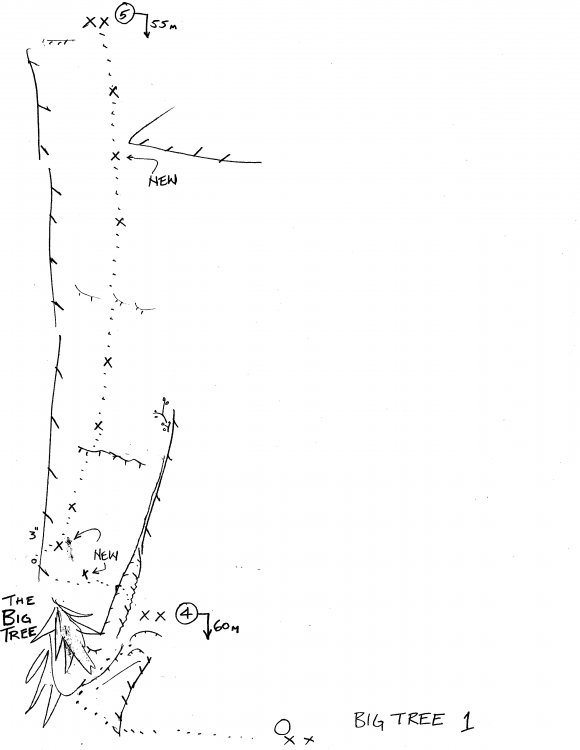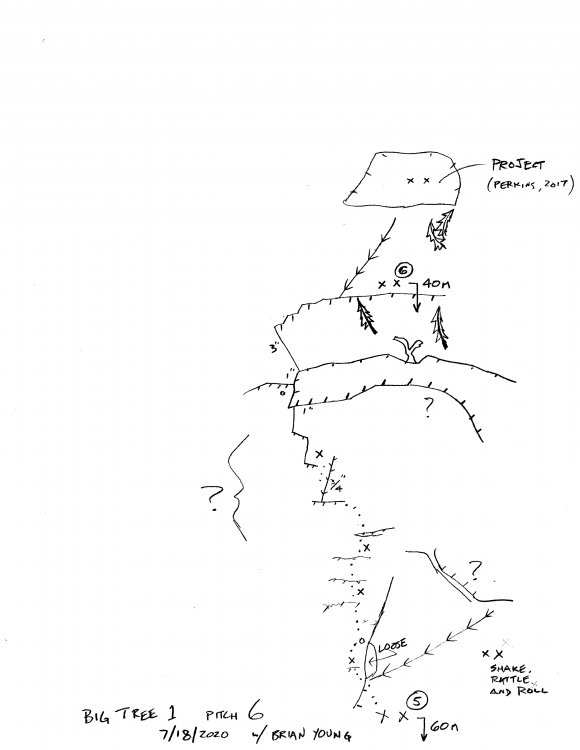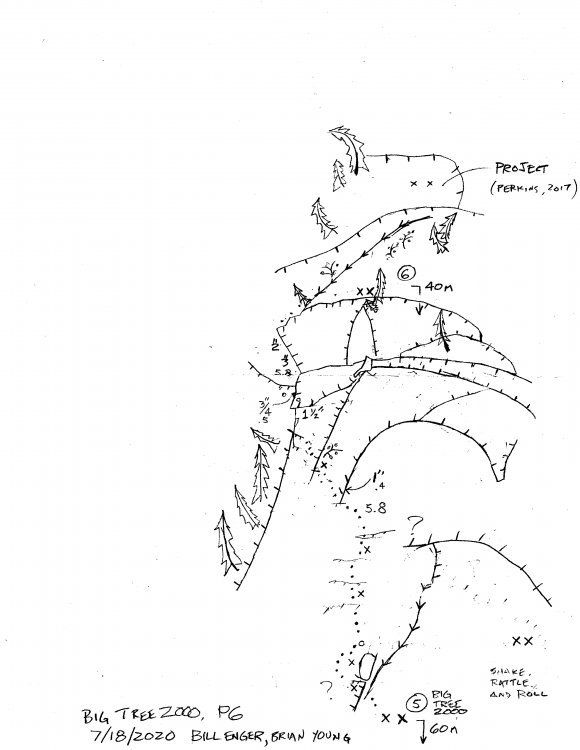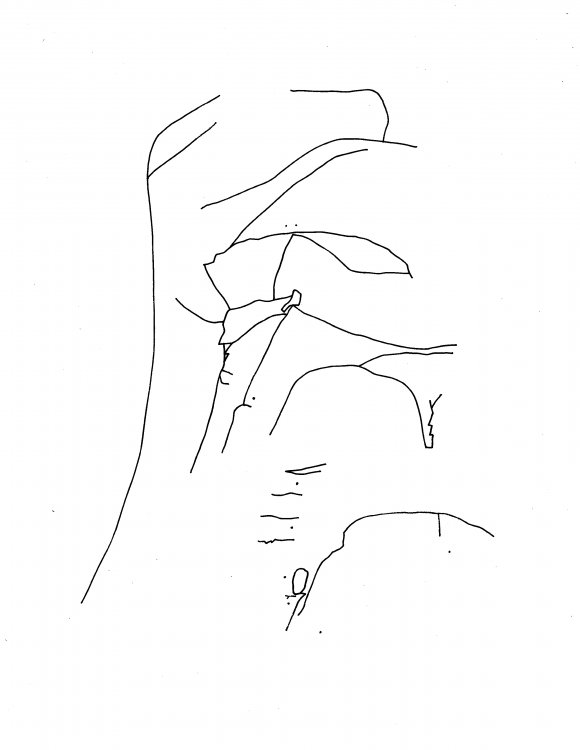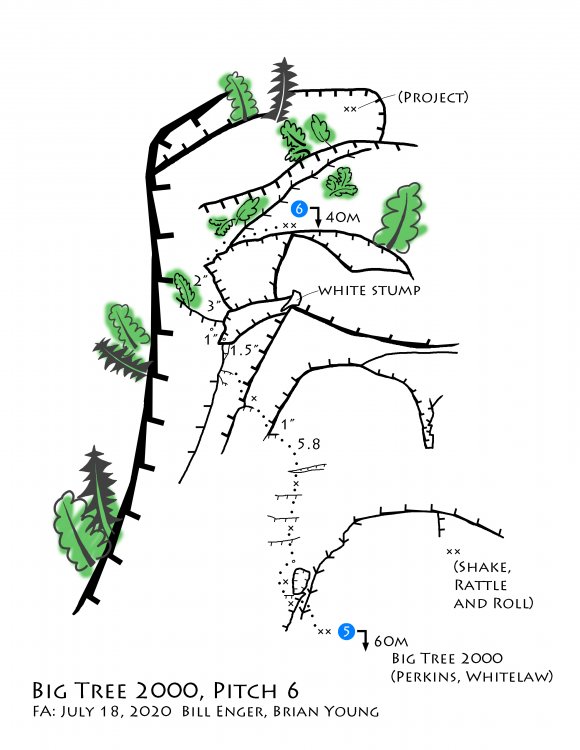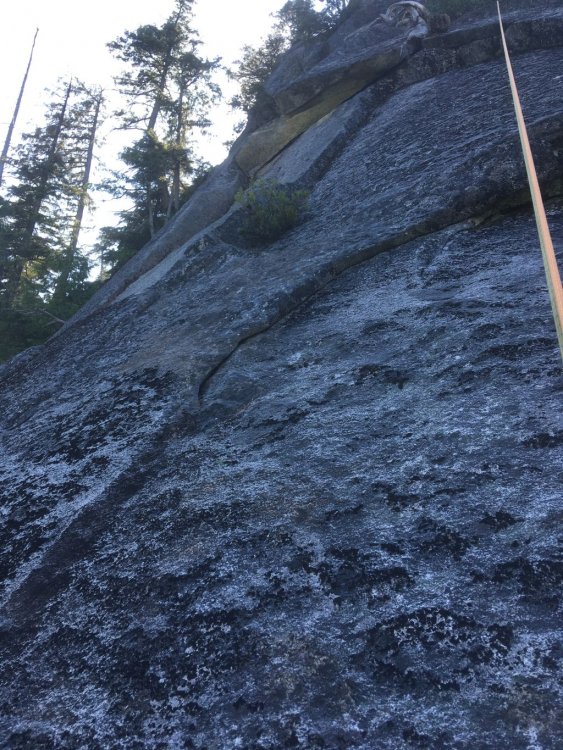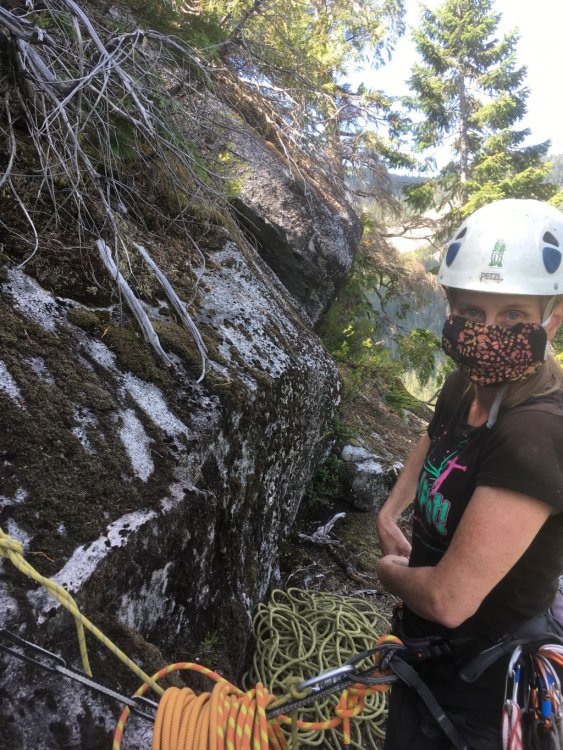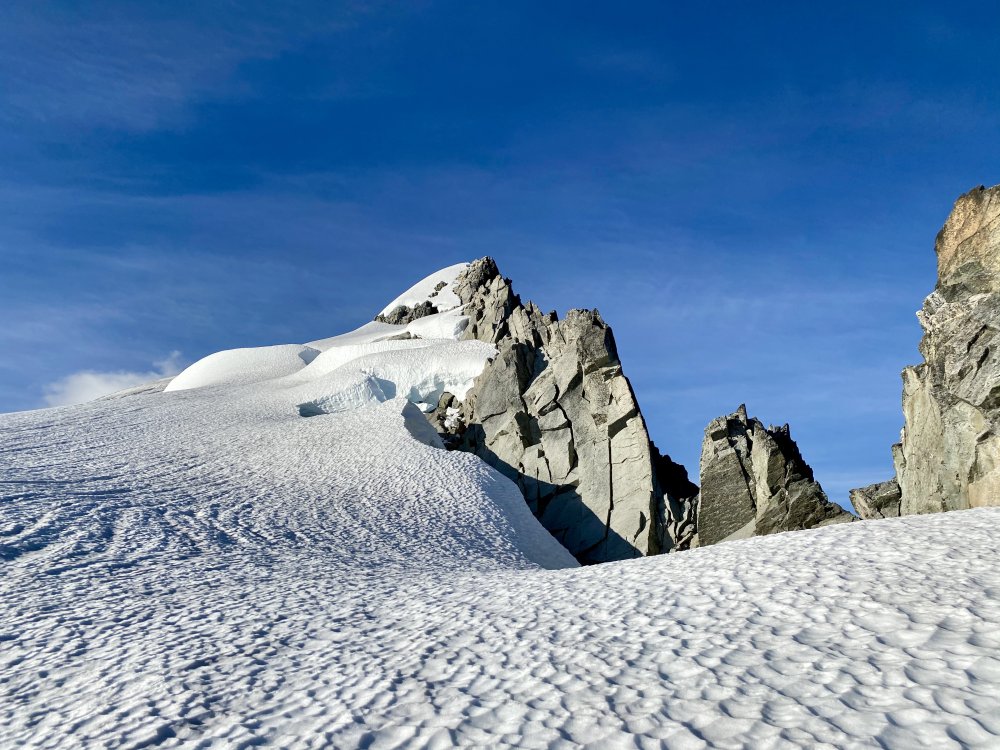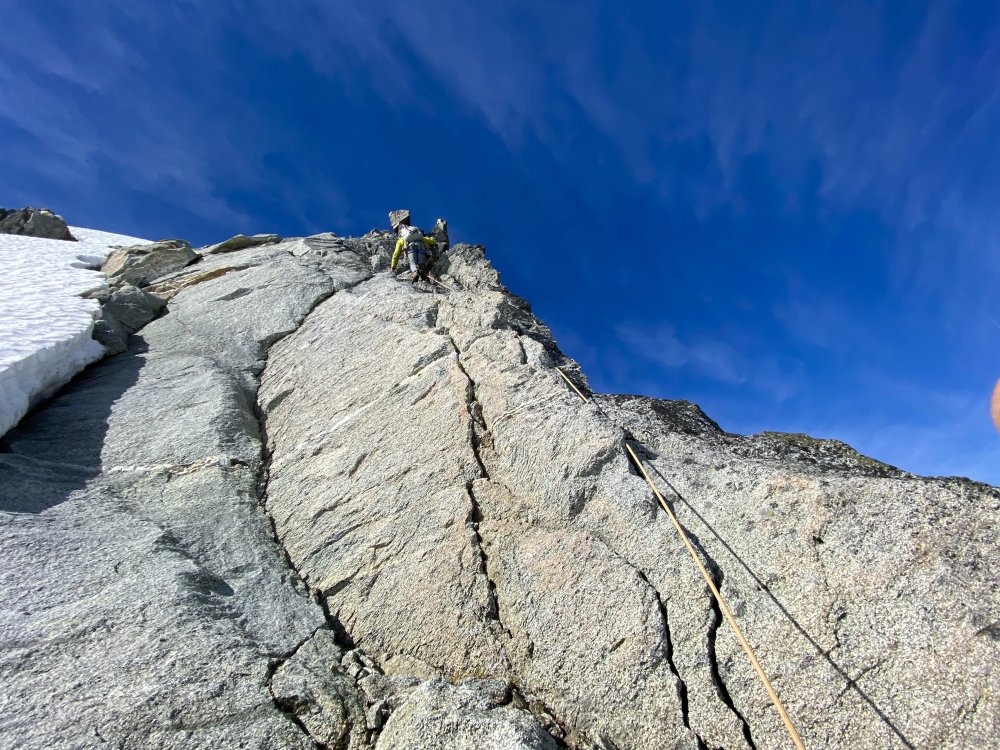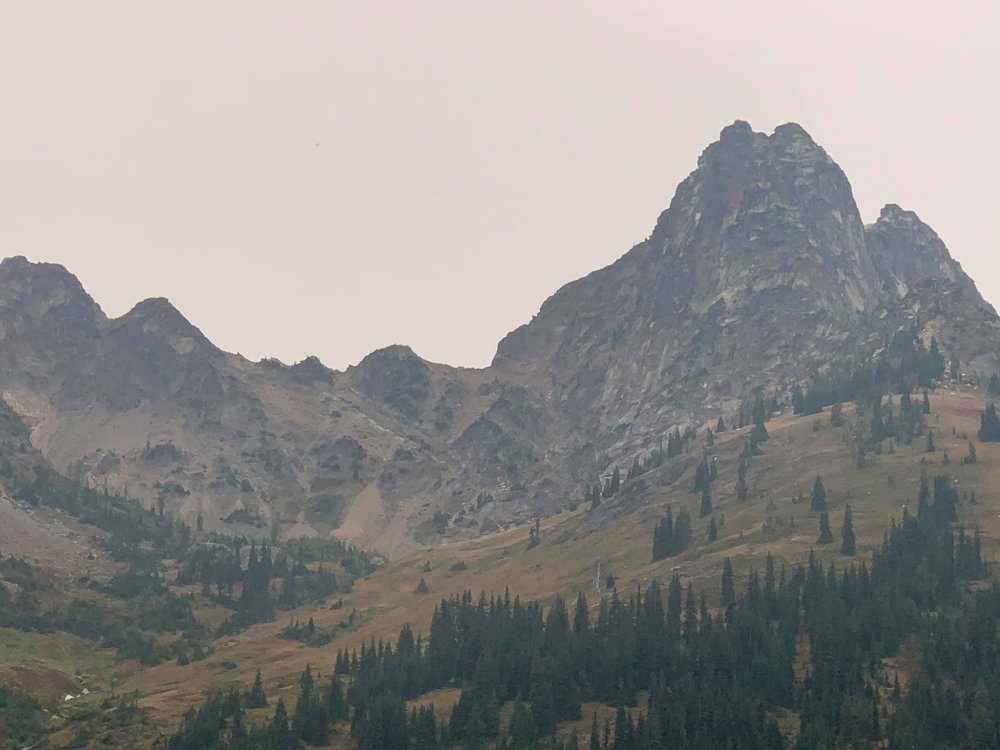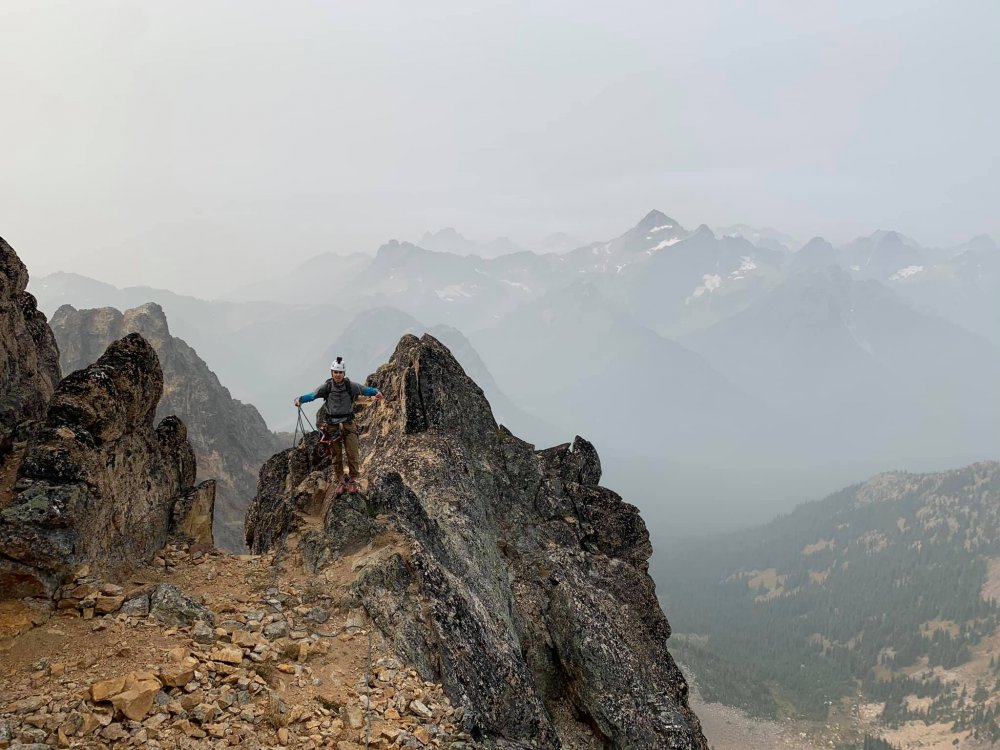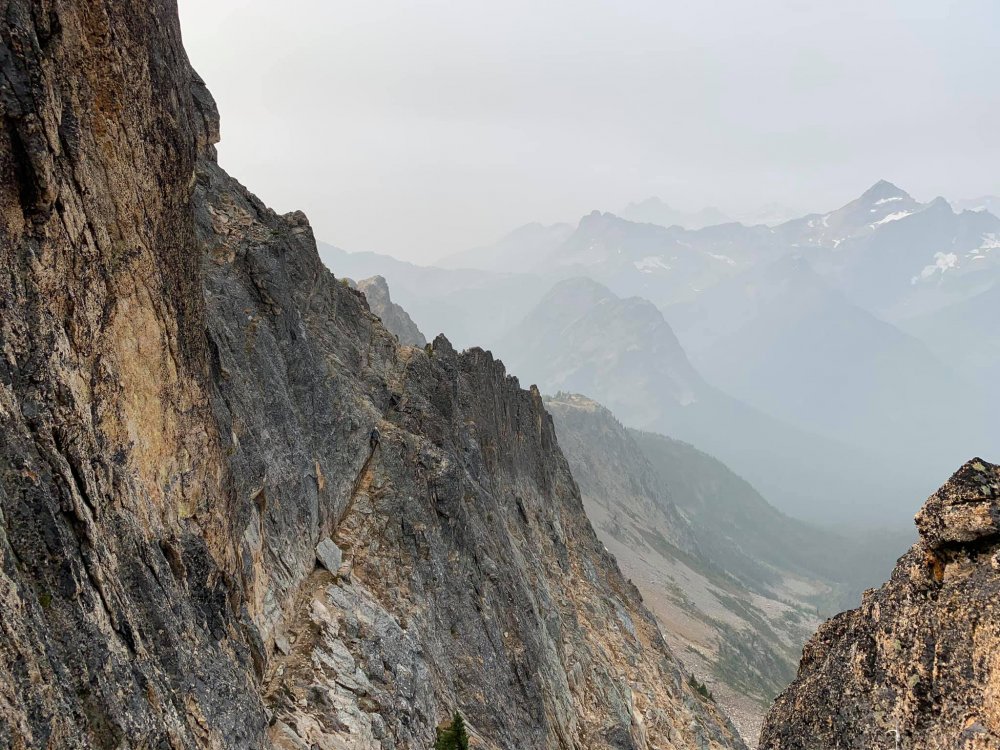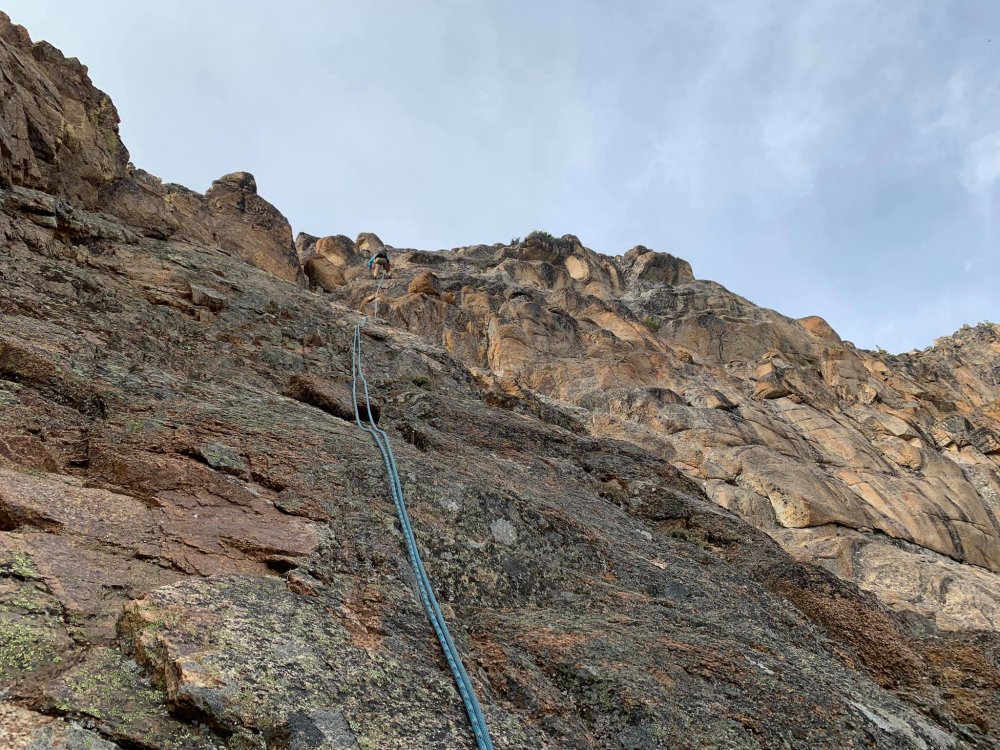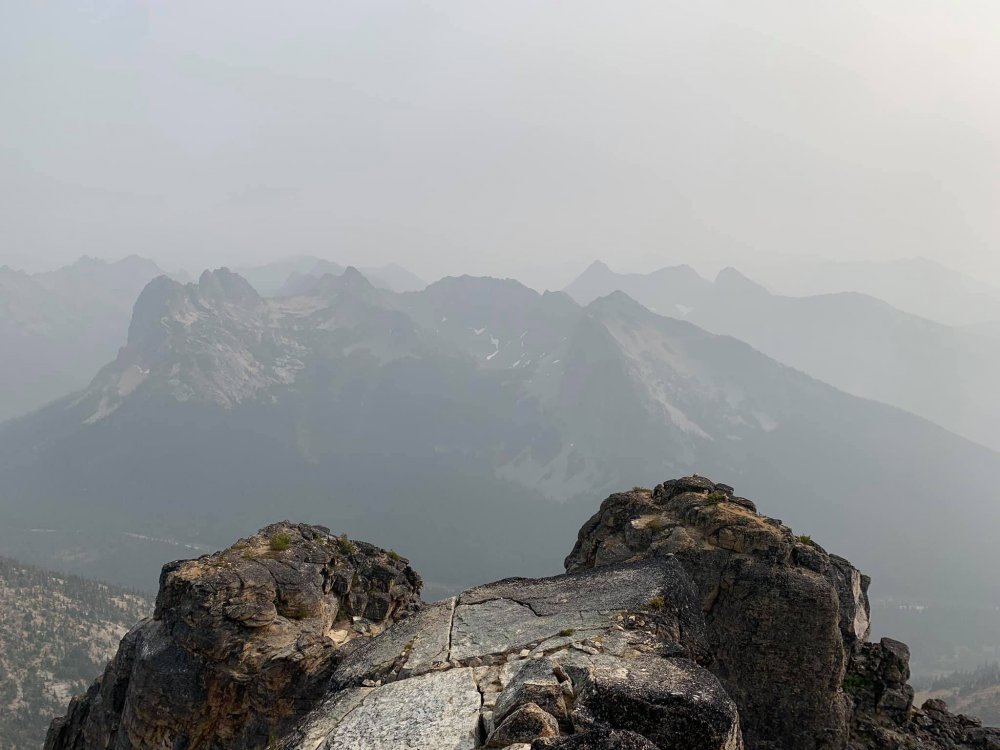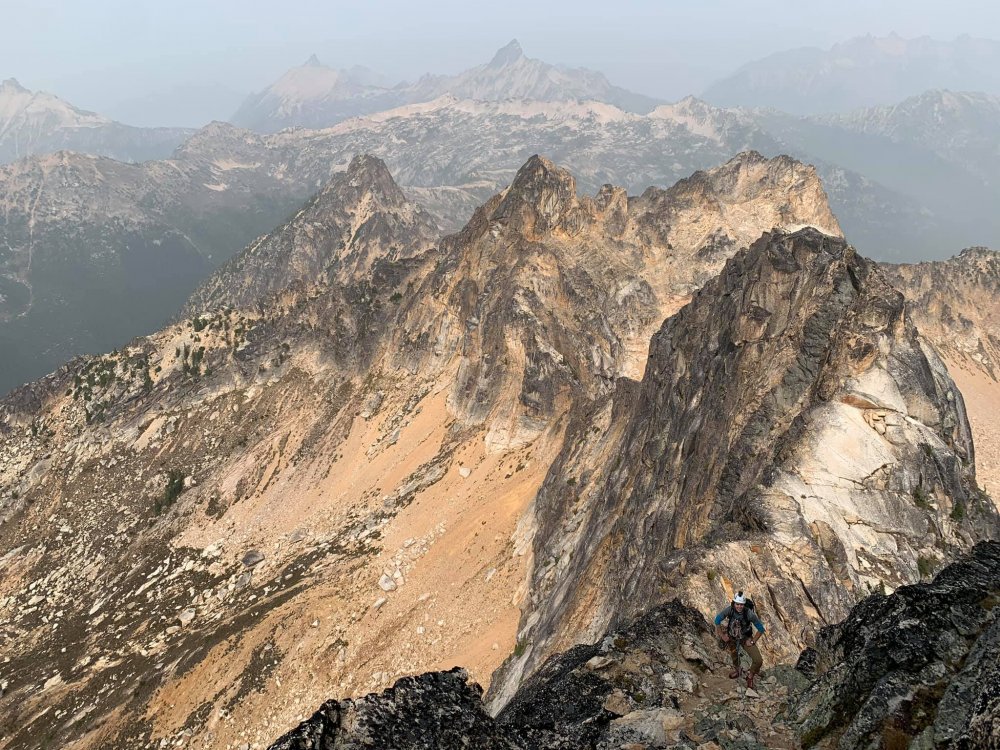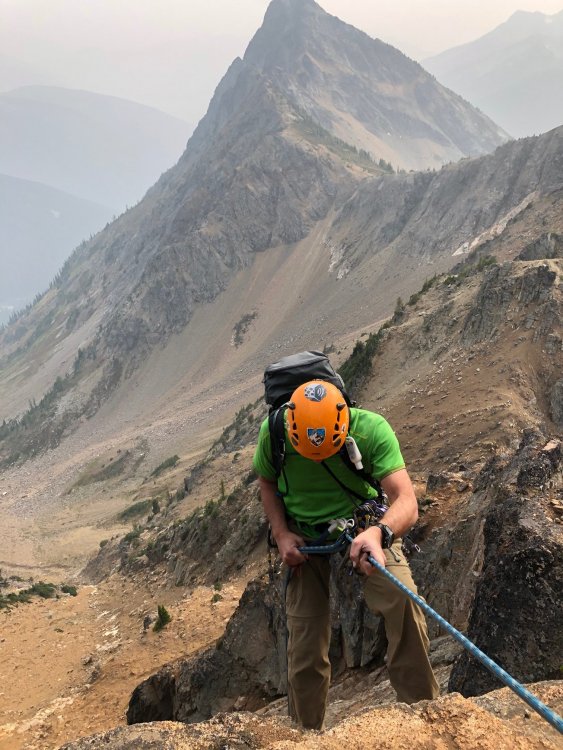Leaderboard
Popular Content
Showing content with the highest reputation on 09/14/20 in all areas
-
Trip: Three O'Clock Rock - Big Tree 2000, pitch 6, 5.8 Trip Date: 07/18/2020 Trip Report: A New Pitch on an Old Favorite Crag The decision to explore the area above the Big Tree was rooted in my desire to finish my Magic Bus Variation route. Yale Lewis and I are in the middle of its final pitch, with two bolts in, bolted on lead, and a long, cool ramp ahead. I wanted to find out if there is a good way to get on top of it to discover the perfect place for the anchor. As this will help to get the pro bolts just right, I'm settling for bolting the rest on top-rope. Since Robin Taft was a willing and dedicated partner for some new adventure, I teamed up with her to do the initial investigation. She leads sport, bolts only, so I had to find ways to keep her interested in the climbing approach. We got there in June to do Shake, Rattle and Roll which ends at an anchor one pitch above the Big Tree. It is a fine slab route, one pitch of which has 12 bolts and no gear placements—perfect for Robin! On the descent, I looked around and noted I have to go one pitch higher to get atop Magic Bus. Also, there is an old pitch up there, ending at roughly the same place, which has rusty quarter inchers and Leeper hangers! So, next time up I came loaded for bear and bolt replacement. Later in June, I chose an unusual method to get back up to the same spot: two pitches of Cornucopia, step right for two pitches of Big Tree 1, then the new connector pitch to Shake, Rattle and Roll, and then the last pitch of that climb. We did all that, and I got out the drill and hammer. Robin was patiently enjoying the sunny day while I rapped and removed four split-shank inch long goobers and hand-drilled them out for modern stainless steel. That is pitch 5 of Big Tree 2000, as described in David Whitelaw's book, Weekend Rock. It looked very cool, but I hadn't led it yet. In early July I returned with my rope solo gear to replace the last two old bolts on P5. To continue, the steeper hump on the left from the belay looked not bad, and the slab above it looked like a continuation of the great slab below. I replaced the last old bolt and top-roped the pitch. Having secured the permission of one of the FA party, David Whitelaw, I added three bolts to the pitch to make sense of it. Two at the bottom to connect to the first bolt, and one before the final bolt. Finally, the stage was set for another pitch. On July 18, Brian Young and I climbed Big Tree 1 to get up there, and the exciting work began. From my journal: "Goal focus is narrow. Launch upward from the Big Tree 2000 top anchor with full drilling gear. Try to get above the Magic Bus line. Brian took the odd pitches, but then declined the 5.9 P5. I led that, the new bolts are good. The pitch bolting seems perfect to me. Brian could not believe that the third bolt was the original first." Brian and I set up at the P5 top anchor. Hammer, drill, six bolts, a single rack and the blow tube. I left the anchor and bolted left around a large loose plate, eight feet in diameter. Trying not to touch it, once on top of the new level I found perfect waves of clean slab just as on Pitch 5. I put in three bolts in a row using the transverse ripples, connected with easy friction moves. Then I had to reach left to a thin ledge with no pro, so I put in the fifth bolt. Cracks led up and left, keeping on the verge of the drop to the Tidbits side of the buttress. I dug out a perfect fingerlock hold in a vertical 1" crack, to a ledge. The final 3" crack is clean and secure to a mossy ledge above a tree. I drilled a two-bolt chain anchor for a restful belay stance. From this new anchor, one can look above and see the bolts called out on Matt Perkins' topo labeled, "Project". As it stands, this 40 meter pitch ends at just the right level for a Magic Bus exploration rappel. My field notes for Pitch 5. For the original topo, see "Weekend Rock", by David Whitelaw Four of the five bolts replaced on Big Tree 2000, pitch 5 My first topo, before I realized this was Big Tree 2000, not Big Tree 1 A later version of the topo In the process of bringing the lines into Photoshop, the feature lines were traced in ink on mylar The final topo Cruising the slab on the FA Brian Richter coming up past the Big Tree to help The start of the new pitch. There is now a bolt to help avoid the hollow-sounding plate above the little overlap One of the 5.8 crux moves is to step left and get pro in the pocket shown Robin at the new anchor Thanks to Brian Young for the long belay session while I worked out the pitch. And to Robin Taft for multiple trips to rebolt and clean it. And also to Brian Richter for belaying another trip up the new pitch to clean and refine it. And special thanks to the slab masters who went first, Matt Perkins and David Whitelaw, whose vision found it and got them a long way up there. Gear Notes: Light single standard rack to 3". Approach Notes: Eight Mile Trail to the South Buttress of Three O'Clock Rock. Climb any route to the Big Tree. Climb Big Tree 2000, pitch 5, 5.9. For a way that is only 5.8, climb Shake, Rattle and Roll and then take a very short rappel to the Big Tree 2000 pitch 5 top anchor. See Matt Perkins' overall topo for the Big Tree Area.3 points
-
Trip: Storm King Mountain (8515’) - North Ridge Route Trip Date: 09/05/2020 Trip Report: Storm King Mountain (8515’), North Ridge Route Trip Report – September 5-7, 2020 I climbed Storm King Mountain (8515’), North Ridge Route. I tried this route last year at the end of July but under estimated the amount of time, effort and amount of route finding required to do the route and had to turn around before making the summit. This year I still under estimated the time and effort required but was able to make the summit due to better beta from my previous attempt last year. It took me 3 days. I started at the Bridge Creek Trailhead off Hwy 20 just east of Rainy Pass. It was an out and back trip using Bridge Creek Trail to North Fork Trail into the North side of Goode and Storm King. The trail is in excellent shape all the way to Grizzly Creek Camp. After Grizzly Creek Camp the trail gets overgrown but is not hard to follow. The adventure starts when you cross the North Fork of Bridge Creek. Down low, after crossing the creek (3100’-3200’elevation), heading up the rocky brushy slope I almost walked into a large Wasp nest in the middle of the faint climbers trail. I got lucky and made a detour around the nest without incident. I followed a faint trail up the tree lined ridge between Goode and Storm King. The ridge tops out at 4700’ on a nice wide fairly flat plateau that would make a great camp, no water though. I continued up the ridge to about 5100’ and started my traverse over to the bottom of the North Ridge of Storm King (5000’). This is the easiest spot to gain the North Ridge of Storm King, right at the base of the glacier. The rock is a mix of Class 3, 4 and low 5th in spots heading up. On either side of the ridge it is steep, sheer rock so you will know if you are off route. It took me 5 hours to go from the base of the North Ridge to the Summit. I summited late at 6:00pm so I headed down to find a place to bivy at about 7200’ next to the snow field separating the upper and lower mountain. I got up early the next morning and started down at 6:30am. Once back at the bottom of the North Ridge I headed straight down and diagonal toward the creek valley below. On the map it looked like the easiest way down (contour line wise). Even though it was the easiest way down to the main creek, it still involved coming down several 10’ vertical drops that required careful Vege-Belaying technique. I usually hate Slide Alder, but in this case, I was very happy it was on the down route as it was very useful. Overall the North Ridge of Storm King is a tough climb. The approach is difficult, the exit is difficult, and the ridge requires your full attention. The trail into the area is long and you will need comfortable shoes to save your feet. There was a search and rescue helicopter flying all over the creek valley and up to the base of Goode on Sunday the 6th. Looks like they were doing a rescue. They spent some time parked on an island in the middle of the creek below. It was a good reminder to keep my shit wired tight doing this route. Hopefully all went well for the rescue operation. Some Tips and Notes: 1. This is a long trip. I should have spread the pain more evenly over the three days. Day 1 go as far up as you can to camp. I thought Grizzly Camp was far enough on Day 1, it wasn’t. 2. The climbers trail up the tree cover ridge between Goode and Storm King is steep and hard to follow. Mostly just look for skid marks from animals and humans to stay on route. 3. There are good camping options at 4700’ on the tree covered ridge and above. The 7200’ bivy spot on the side of Storm King is pretty good, If I had more of my gear with me it would have been very pleasant. There was water all along the route where there was melting snow/glacier. 4. A rope would probably be a good idea to bring along. Rappelling would have been nice in several spots but you would definitely have to watch for loose rock coming down on you as you rappel. A didn’t bring a rope to save weight and it worked out fine for me. 5. I brought an Ice Axe & Crampons and didn’t use them. Maybe early in the season they would have been needed. Travel Time for reference: Day 1 (TH to Grizzly Camp), 4.5 hours – Day 2 (Grizzly Camp to Summit to 7200’ bivy), 12.5 hours – Day 3 (7200’ bivy to TH), 14 hours. Gear used: Trekking Pole, Helmet, Ice Axe, Crampons, Full Gaiters, Work Gloves Wasp nest down low after crossing North Fork Bridge Creek around 3100-3200' Climbers Trail up tree cover ridge between Goode and Storm King View from 4700' ridge plateau Potential camp at 4700' ridge plateau Full view of North Ridge of Storm King. Start of ridge is the at the bottom right where the heavy shadow is (5000'). North Ridge start location (5000'). Get used to this view for the next several hours. View off to the side of the North Ridge. Storm King - "Where Echoes Go To Die" - I believe it, must have been climbing the North Ridge. Goode looking sexy like usual. Wish I had more time on the summit to enjoy the view, it was stunning. End of the Exit route. Farewell Storm King - North Ridge. Until we meet again, may God hold you in the palm of his hands. Gear Notes: Trekking Pole, Helmet, Ice Axe, Crampons, Full Gaiters, Work Gloves - Didn't need the Ice Axe or Crampons Approach Notes: Bridge Creek Trailhead - Bridge Creek Trail to North Fork Trail & back2 points
-
Trip: Eldorado Peak - North Ridge Trip Date: 09/07/2020 Trip Report: Climbed one of the lesser trafficked routed on Eldorado Peak with Will Gordon. Very nice climbing and managed to get in and out before the smoke For those who care: gethighonaltitude.com/2020/09/07/eldorado-north-ridge/ Gear Notes: Standard alpine rack Approach Notes: Camped at 7400' camp2 points
-
Trip: Three Sisters Marathon - Standard Route(s) Trip Date: 08/22/2020 Trip Report: Summary: Drove over to Pole Creek from Portland on Friday 8/21, even though the USFS website says the area is closed. Based on the fact that there were 50 cars at the trailhead, no one was fooled. My timeline is below. Certainly not bragging, but perhaps indicative of what a normal person could expect as opposed to the athletes on this site. I think I went the way most do. Up the SE Ridge of North, down the S Ridge across the snow and up Middle, down the S side of Middle and up the N Ridge of South. 4:00am - Departed Pole Creek Trailhead 4:30am - Begin bushwhack just past Soap Creek (lots of windthrow) 9:03am - Summit North Sister 12:12pm - Summit Middle Sister 5:06pm - Summit South Sister 7:56pm - Back at Camp Lake 11:45pm - Back at car at Pole Creek 11:46pm - First sip of cold beer all day (Russian River Blind Pig IPA) 11:47pm - Remove shoes 3:30am - Arrive home in Portland Beta: There is a lot of windthrow after you leave the trail near Soap Creek. In the dark, it is harder to pick your way through. There is no snow or ice on the Traverse or in the Bowling Alley. I climbed up the right side of the bowling alley on the "more solid" rock that looks back down over the Traverse. There is a piece of pro that someone left mid-traverse, but they forgot my fixed line. There are at least two fresh slings on the main rap rock at the top of the Bowling Alley. And, over on the North Ridge of South Sister, someone was nice enough to leave a rope, leading around the last band of rock, just below the lower-angle section at the top. Slings there not quite as fresh! Observations: I'm getting way too old for this. This is very likely the last time I go up North Sister. After you get about 8 miles from a trailhead, there are very few people who are not really fit. There are lots of butterflies up top right now! Now, I totally understand why people drop a car at the other side of South! Photos: Took a few, but I will spare you the selfies of my ugly mug holding up one, two, and three fingers at the top of each hill! Gear Notes: Tennis Shoes and water Approach Notes: Pole Creek TH up SE Ridge of North Sister and onward1 point
-
Trip: Cutthroat Peak - West Ridge with North Ridge finish Trip Date: 09/13/2020 Trip Report: After a couple disappointing attempts into Depot Creek I settled for a rock climb this weekend with my son. The smoke made multiple days seem unappealing but I figured a one day climb would be a reasonable compromise. My son and I headed out to WA pass mid-afternoon on Saturday, stopping in Marblemount to retrieve some items we had stashed in bear lockers on a previous trip that the maintenance crew took. We then proceeded to Lone Fir Campground for a relaxing evening before an early morning start. Alarms went off at 5:20 (damn it's dark now at that time!), and we drove to the pullout below Cutthroat. The smoke seemed to have worsened from the previous day, despite what we were expecting from reading forecasts. Oh well, we were there. View up in the morning: We made quick work of the approach to the base of the route around 7500'. We opted for the start just right of the prominent dihedral (with a wide crack) on the S side. The climbing started at class three then got harder and more exposed. I never saw any fixed pitons (I expected two) and ended up climbing to rap chains in one long 60m pitch. Later we found that this is the middle set of chains for the descent from the ridge crest. From here I led a shorter pitch to the crest and the top chains. This had a few rock moves mixed with scrambling. We then unroped and moved the belay as far as we were comfortable. There is one section of the ridge that becomes exposed on both side and requires moves around small micro-gendarmes that we didn't want to solo. So we backed down a few feet, built an anchor and simul-climbed the exposed section to a flat spot. View to the summit block from the exposed ridge: My son at the end of the exposed section: From here we opted to traverse the ledge to a notch in the upper N ridge. We simulclimbed that as well, but realized it didn't really require it (much less exposed than what we had just done). Ledge leading to the N ridge as seen from the N ridge notch: From the notch on the N ridge, I led a fun pitch up 4th and low 5th class rock until the terrain moderated to a scramble that led to the summit. Summit views S (very smoky): Summit views North (clearing some): After enjoying the summit for a while and fueling up, we began our raps down to the W ridge. We were expecting two 30m raps off of chains, but the 2nd rap dumped me on sketchy class 4 terrain, so I climbed back to the rope, attached a prusik, and climbed back to a 3rd rappel station (not chains, but quite elaborate set of round webbing/cordelettes). Me on upper rappel: We then simul-climbed the short exposed ridge section, downclimbed to the bolt anchors on the lower ridge and did 3 30m raps back to the base. Lower rappel. Note improved air quality by later afternoon The hike out was pleasant and we got to the truck just after 6:30, making it a 12 hour day. Gear Notes: Alpine rack up to 2" Approach Notes: Zero snow. Compared to other trips this summer, not too chossy1 point
-
Thanks for the good trip report and photos. I'd like to get up that some day, looks cool.1 point
-
Stuck at home today? Please take this WTA survey about the Mountain Loop. Your input will help shape the future of the trails network around Pilchuck, Vesper, and other hiking and climbing areas in this zone. We want climber voices to be heard. Thanks! Survey1 point
-
Trip: Chiwawa (8459') & Fortress (8674') Mountain - East Ridge Trip Date: 08/29/2020 Trip Report: Chiwawa (8459') & Fortress (8674') Mountain, East Ridge Trip Report – August 29-31, 2020 I climbed Chiwawa Mountain (8459') & Fortress Mountain (8674'), the East Ridge Route for both, in a big loop. It took me 3 days but can be done in 2 long days. I started at the Trinity Trailhead off Chiwawa River Road North of Lake Wenatchee. I went up Trail 1550 (Chiwawa River Trail) all the way up along the side of Red Mountain to about 6580’ elevation. The trail is in pretty good shape and narrows to a goat trail towards the end. I traversed diagonal and up toward the East Ridge of Chiwawa Mountain. I got onto the East Ridge of Chiwawa Mountain too early, as it look pretty nice from below. The rock was rotten, loose and steep along the ridge until I was about ¾ the way to the summit. I ended up using ledges and goat trails to get onto the better part of the ridge. Travel was slow due to the rock quality. There is a ridge/buttress that drops South from the middle of Chiwawa, you want to go below and around that before heading up to the East Ridge. Doing this will avoid the majority of the rotten rock on the lower part of the ridge. I summited Chiwawa around 5:00pm and setup camp on the summit. There is a campsite on the summit that is nice that has room for two maybe three if you want to get close. It was surprisingly cold and was fairly windy. I was glad I brought extra insulation. I had a water bottle next to me that was half frozen by the morning. If there was precipitation, it would have snowed. I started out for Fortress Mountain from summit camp at 8:00am. There is a really nice camp at the Col between Chiwawa and Fortess at about 7200’. It has plenty of room for tents and good access to water. I would have camped here instead of the summit of Chiwawa if I had known it was there. Although the Chiwawa summit camp was nice & had a great views, just no water. I used Crampons and an Ice Axe crossing over to the East Ridge of Fortress on firm snow. I climbed a gully of loose rock, class 3 some 4 to get onto the East Ridge of Fortress. Once on the ridge the rock was decent. The 4th class step to get to the summit is exposed, so make sure your holds are good. I summited Fortress around 12:30. Fortress Mountain has one of the best views of Glacier Peak that you can get, enjoy. I headed down to Pass No Pass from the summit. I initially headed down the northwest rocky ridge thinking it was the correct way down, it is not, the rock turns to loose steep garbage. I corrected my course and headed down the ridge that leads toward the beautiful grassy meadow plateau (another great camping option) heading north toward Glacier Peak. I kept heading down the ridge until I reached Pass No Pass which is also a fantastic camping area. I headed down light trail to the main Buck Creek Trail #1513 and followed this trail all the way back to the trailhead. Overall the loop trip was very nice. The rock on these two mountains is loose for the most part so be ready to slip and slide. The views are fantastic. Fall is in the air so be ready for cold temperatures. Some Tips and Notes: 1. Chiwawa’s East Ridge is mostly steep loose rock. Connect to the East Ridge after you round the South buttress/ridge to avoid most of it. 2. The trail from Pass No Pass to Buck Creek Trail splits into several different trails along the way. You will have to do a bit of head scratching. As long as you are heading down you should run into the Buck Creek Trail. 3. Along the route there are good camp spots at: The summit of Chiwawa (no water), The 7200’ Col between Chiwawa & Fortress (good water source), The grassy/sandy meadow plateau below Fortress 7100’ (some water), Pass No Pass area (good water source), several campsites along Buck Creek Trail. 4. Buck Creek Trail is long and boring so bring comfortable shoes. Travel Time for reference: Day 1 (TH to Chiwawa Summit), 9 hours – Day 2 (Summit of Chiwawa to camp off Buck Creek trail), 10 hours – Day 3 (camp to TH), 2.5 hours. Gear used: Trekking Poles, Helmet, Ice Axe, Crampons Chiwawa Mountain (right) & Fortress Mountain (left) from west side of Red Mountain on Chiwawa River Trail. Upper Chiwawa River Trail on side of Red Mountain 6500' elevation. Chiwawa Mountain East Ridge on Traverse from side of Red Mountain. Sample of lower East Ridge rock on Chiwawa Mountain. Chiwawa Mountain Summit Camp (8459'). Snow crossing from 7200' Col to Fortress Mountain East Ridge. Fortress Mountain East Ridge. Fortress Mountain Summit (8674'). Pass No Pass & Helmet Butte. Gear Notes: Trekking Poles, Helmet, Ice Axe, Crampons Approach Notes: Trinity Trailhead. Chiwawa River Trail 1550 up the side of Red Mountain. Buck Creek Trail 1513 return to TH.1 point
-
Did the marathon yesterday but went up the West Ridge of South https://imgur.com/gallery/yYDUvoc and got a ride back to Pole Creek Trailhead (cheating). See attached GPX of the route. There is small stream of water to climber's right coming off the snow between Middle and North in the saddle - didn't get any from this. Between Middle and South there is a snow field near the bottom on descender's right which had a nice stream of water that ran into one of the Chambers Lakes - drank from this. There was also a nice stream at the plateau north of the West Ridge - drank from this. I took 4 liters and wished I had 6, it was warm though. Probably drank 1.5 liter of water from the snow melts. Three Sisters Marathon - S Sister W.gpx1 point




